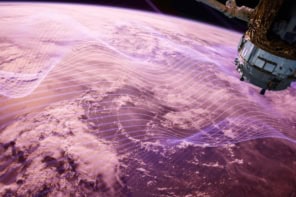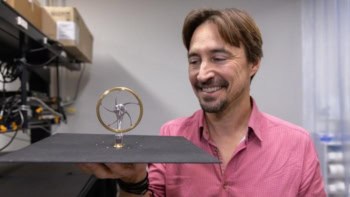The future of the wind industry is looking brighter thanks to a decades-old laser technology. Jon Cartwright explains how laser anemometry could cut the cost of wind energy and boost its share of the world’s energy market
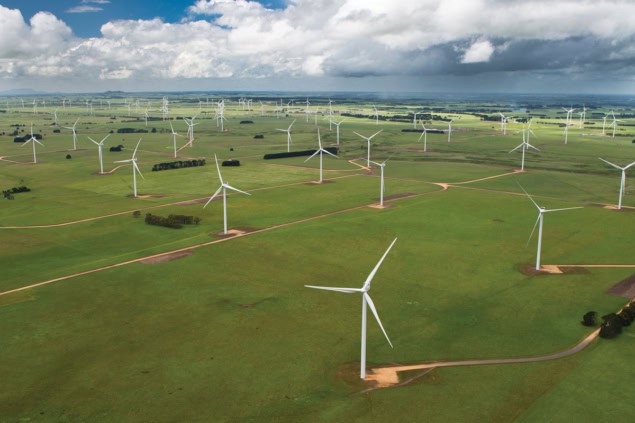
On a coastal plain in Østerild, north Denmark, a gargantuan white structure turns solemnly in the breeze. The latest wind turbine designed by the Danish manufacturer Vestas, the V164, is the biggest yet: at 220 m, it is well over twice the height of the Statue of Liberty. And when it was finally tested in Østerild at the beginning of 2014, it also proved to be the world’s most powerful – capable of generating 8 MW of power, enough to provide electricity for some 7500 homes.
The V164 is a symbol of the wind industry’s recent success. Over the past 14 years, the number of installed turbines across the world has risen dramatically, from an output of just 17 MW in 2000 to nearly 320,000 MW last year – corresponding to about 4% of the world’s total energy demand, according to the Global Wind Energy Council. The boom has been due partly to a surge in the construction of turbines in China, but many smaller countries are also adopting the technology. The UK, for example, generated 10% of its electricity from wind power last year, and it has more offshore wind capacity than the rest of the world combined.
Despite this success, however, the industry has sometimes struggled politically – not least because of a conflict between the cost and location of wind farms. Onshore wind power is relatively cheap: it costs about $87 per megawatt-hour, midway between natural gas ($66/MWh) and coal ($100/MWh), according to a 2013 report by the Energy Information Administration (an agency of the US Department of Energy). Plans for new onshore wind farms often face strong local opposition, however, which is why politicians frequently look offshore for new opportunities. But offshore wind is far more costly: the same 2013 report rates it as more expensive than nearly any other energy technology – renewable or otherwise – at about $222/MWh. The high cost of offshore wind was highlighted in March this year when Scottish and Southern Energy, a UK gas and electric company, announced that it would cut its investment in offshore turbines in order to assure a two-year price freeze for its customers.
The industry’s continued success, therefore, depends on finding ways to cut costs. One avenue that physicists and engineers are currently exploring uses lidar – essentially a laser version of radar – to improve the siting of wind farms and reduce maintenance costs. Lidar systems can measure the pattern and strength of wind at a distance, which gives wind-energy firms a better idea of how windy a certain location will be before they make the large capital investment required for a new wind farm. Better real-time information about how atmospheric conditions are changing could also make it possible to prepare turbines for outbreaks of turbulence, reducing the risk of expensive damage. The hope is that with a little help from light, wind power will become a more cost-effective technology.
New uses for old physics
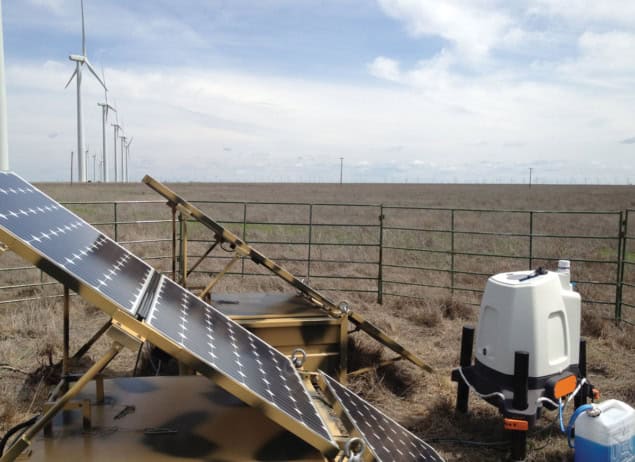
In the simplest form of lidar, laser light (typically infrared) is projected outwards and bounces back off whatever is in its path, including buildings, water, terrain or even – since the wavelength of light is so short – tiny particles in the atmosphere, such as dust and water droplets. The distance to such objects can be calculated from the time it takes for the light to return, or selected in advance by adjusting the laser beam’s focus. Meanwhile, the speed of the objects is calculated from the Doppler shift of the returning light: if the object is receding, the light will be red-shifted, while if it is approaching, the light will be blue-shifted.
In itself, lidar technology is not new. Its development dates back to the late 1960s, when defence experts and meteorologists became interested in using lasers to monitor wind patterns for aircraft landings and measure the distance and size of clouds. Since then, lidar has been used for applications as varied as mapping terrain and crime scenes; making digital models of cities; capturing tiny features of building façades for restoration; checking the speed of motorists; navigating autonomous vehicles; and estimating the concentration of atmospheric pollutants. It has even been used to measure the distance from the Earth to the Moon.
But although lidar is considered a mature technology, many of these well-established applications require lidar units that are far too complex for non-specialists to handle. “You’d need a truck load of PhDs to operate them,” says Mike Harris, chief scientist at ZephIR Lidar, a company based in Ledbury, UK. Another problem is that lidar units tend to be fragile, and are thus unsuitable for use over windy seas or terrain.
The source of both troubles, Harris explains, is that many lidar units have a very small tolerance for optical misalignment. This is especially true of lidars that measure Doppler shift, since they commonly compare the reflected light with a reference beam using interferometry. In this technique, small changes in the wavelength of the reflected light cause it to “beat” with the reference beam, and the timing of these beats reveals the precise extent of the Doppler shift. Since the wavelengths of light are on the order of a micron, the components inside the interferometer must be aligned to within a fraction of a micron in order to give an accurate measurement.
A solution to these problems began arriving in the 1990s, with the widespread adoption of optical fibres by the telecommunications industry. Suddenly, optics became more like electronics: laser light could be routed around enclosures compactly and with high precision, using the optical fibres like wires. And, crucially, fibre optics could suffer exterior movement without having to be re-aligned. “The requirements of the wind industry are pretty stringent,” says Harris. “You’ve got to sit the piece of kit out on the hillside with no maintenance for months on end. And you’ve got to get it there, so it’s got to be light.” Today, says Harris, the performance of lidars is not in question, although further improvements in their cost and reliability might make it more practical to mount them on large numbers of turbines.
Finding sites
Past efforts to reduce the cost of wind power have often focused on turbine technology. As a result, modern wind turbines have become incredibly efficient, capturing nearly 60% of the wind’s kinetic energy – close to the theoretical maximum as calculated in 1919 by the German physicist Albert Betz. Further cost reductions will require a different approach, and lidar technology could make a contribution in several ways.
One of these concerns the siting of wind farms – what the industry terms “resource assessment”. Evaluating a site’s suitability for a wind farm is a major expense for energy companies, requiring wind measurements at multiple points over an extended period, typically one and a half years. Only with such exhaustive measurements – supported by comparisons with historical meteorological data to check there are no anomalies – can a company persuade a bank to lend the initial capital. “It’s no good just putting a wet finger in the air and saying, ‘Yes, that’s windy enough’,” says Harris.
In the past, energy companies have performed such measurements with meteorological masts, commonly known as “met masts”. These masts support anemometers to measure wind speed directly, and must be built into the existing terrain on strong foundations. This doesn’t come cheap: a single offshore met mast, sunk into the seabed, costs around £15m. Performing siting measurements with lidar is inexpensive by comparison. ZephIR’s floating lidar units, for example, cost as little as £500,000 each and have the added benefit of being reusable, so they can be moved around a site or even taken from one site to another. The benefits of lidar for resource assessment were quantified earlier this year by the international renewable-energy consultancy Ecofys, which estimated that using lidar could lead to a total return on investment of as much as 14.5%, as opposed to 11.8% with met masts.
The other main application of lidar in the wind industry involves making measurements of atmospheric conditions up-wind from operating turbines and using these data to prepare for turbulence. If a turbine is subjected to turbulence it is unprepared for, its blades can suffer extremely high loads that, while not necessarily leading to sudden failure, can cause accumulated fatigue that costs millions to repair. “It’s a bit like driving over a pothole,” says Harris. “It knackers your suspension.” In 2008 a wind turbine near Hornslet in Denmark exploded, apparently because costly maintenance had not been carried out on its gearbox.
One idea is to build a lidar unit into the hub at the centre of a wind turbine, where it can analyse the pattern of incoming wind. If turbulence is known to be imminent, the pitch of the turbine blades can be altered so that they cause less wind resistance and, as a result, suffer a reduced load. This will lower the maintenance required for existing turbines, but Harris believes it could also enable turbines to be manufactured more cheaply, because they would not have to be “over-engineered” to prevent failures such as the one near Hornslet.
Making a contribution
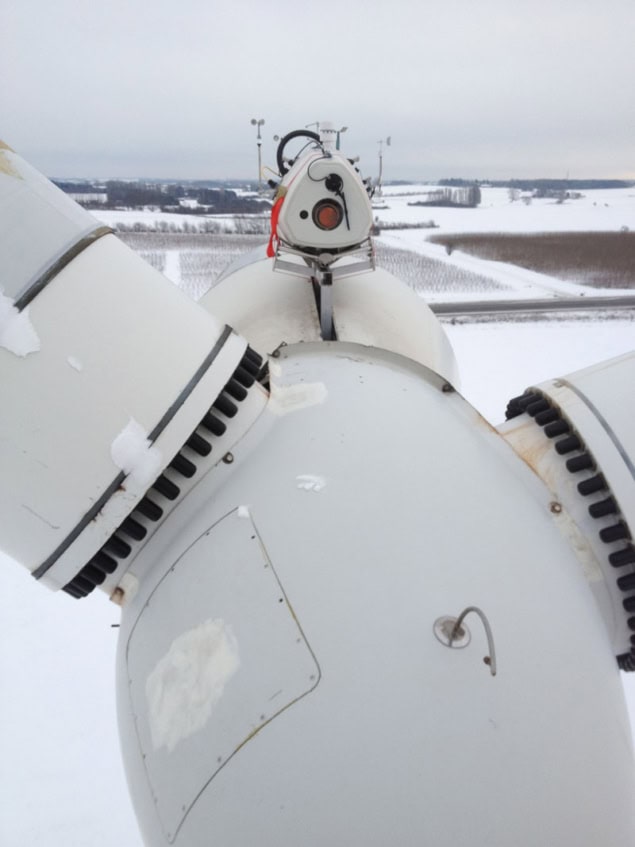
The idea of using lidar to prepare turbines for turbulence is attractive, but it is not the only solution. Some engineers are experimenting with integrated load sensors that quickly detect the onset of turbulence and adjust the blade pitch accordingly. Furthermore, some turbines are being developed with systems that control the pitch of individual blades, meaning that the response to turbulence could vary from blade to blade. This level of control is important because eddies can be very localized, and, under these circumstances, “having a lidar to look upstream is probably not going to help you”, says David Infield, a mathematician and expert in wind power at the University of Strathclyde, UK.
Infield is also unconvinced that lidar units offer a comprehensive alternative to met masts. In some cases, he argues, “there’s going to be issues over whether a company would want to leave an expensive lidar unit on site for a year or more”. Nonetheless, he believes lidar technology has some attractions for the wind industry. “The benefit of lidar is that it can give a much more complete description of the wind’s shear profile, and, especially on shore, you can deploy [lidar units] relatively straightforwardly,” he says. “At the moment, my understanding is that [energy companies] are usually using it to complement long-term measurements from masts.”
Lidar could also have uses for wind-power research. At Strathclyde, one of the world’s leading centres for such studies, scientists have been using lidar to understand the 3D pattern of turbine wakes, and how they affect the performance of other, downwind turbines, Infield says. Meanwhile, researchers at ZephIR are trying to attach lidar units to turbine blades, to understand how they are interacting with the wind in real time. Such investigations could ultimately lead to better-performing and more cost-effective wind farms, although Harris warns that there is a lot of uncertainty in the accuracy of lidar data, depending on the frequency of scanning and other details.
But regardless of where lidar is ultimately applied in the wind industry, it seems destined to lead to improvements. The pioneering work of ZephIR has already been honoured, with the UK secretary of state for business, Vince Cable, presenting the company last year with an Innovation Award from the Institute of Physics (IOP), which publishes Physics World. “ZephIR has addressed an ongoing problem for firms trying to bring affordable and reliable wind power to the grid,” said the IOP president Sir Peter Knight. “It is highly deserving of this award.”
Harris, however, prefers to remain modest about the potential of his company’s technology. “It’s certainly got a contribution to make,” he says. “Not on its own is it going to drag the wind industry from any current perceived problems – but it’s got a contribution to make.”


